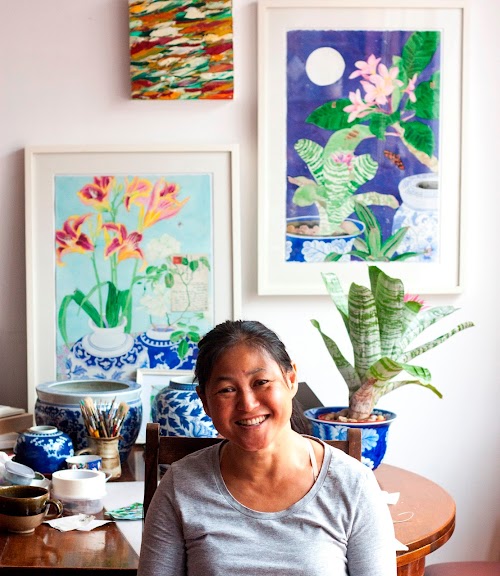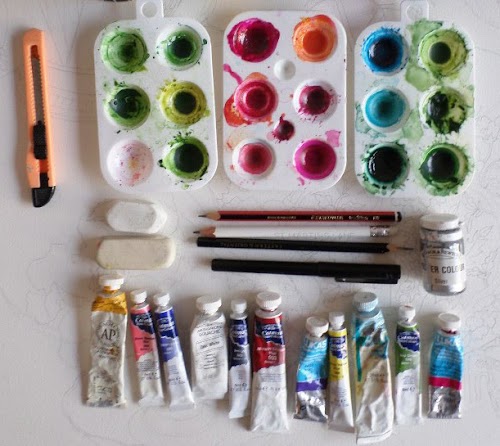Our interviewee today is artist Gabby Malpas. She's from New Zealand, a long time resident of UK and now staying in Sydney.
She was trained as a potter in New Zealand, but has since moved to using watercolours and ink to create her artworks. Her artworks are images of mainly of still life, things that are bought, eaten and picked around Sydney.

You can check out more of her works at
https://www.mangofrooty.blogspot.com
https://gabbymalpas.com/
Facebook
Flickr
Qn: Can you tell us what you do for a living? I read on your blog that you're a digital project manager?
I project manage and account manage online and design projects for corporate clients. Much of the work was spent in agencies in London then Sydney but for the last 8 or so years in Sydney (and 2 in London), I've been freelance and working remotely, from home for a number of clients. I have 20+ year experience in this field and it's funny that I am considered senior but with art, I have been practising for over 25 years and would be considered: 'emerging'.
Believe it or not - although I did get lucky and "fell" into the digital world, being in the right place at the right time - this does fit in with my life plan of working part-time and painting part time. One day I would like to be painting full time but the reality is that I'm still working on getting to be known and bills need to be paid.
I figured very early on that I needed to be able to pay for what I wanted to and casual/unskilled jobs wouldn't really allow me to do that in the long run.
In the last couple of years I completed a training qualification and have started running small art classes locally for adults and children.
Qn: Why did you switch from pottery to painted media?
Ahahaha. Quite frankly I was breaking more than I completed, I was planning to travel and it's prohibitively expensive to practise.
I have the greatest respect for ceramicists out of most art forms because really, I know how heartbreaking it can be to see an entire kiln-load get ruined.
If I am also truthful - to my shame I was a very bad student and did not ground myself properly in the technical skills to continue alone. I have promised myself I will return to it one day.
When I started travelling, paper and paints were a much more viable option.

Qn: Can you give us a rundown of the tools in the picture above?
OK, the picture above (not the one with the glue in it) contains the following:
Kraft knife - this must be a lucky knife. I think it cost me about 50p 15 years or so ago and I still have it. Although when I work on paper I generally tear the pieces into the sizes I want because I like the rough edges, I use the knife to score and help cut paper from large rolls for bigger pieces.
Plastic paint trays - I buy cheap plastic paint trays from $2 shops and supplies shops anywhere I see them. Being small, they are easy to hold and with a small number of wells you can limit the colours to one per tray then mix colours of that hue within each.
Erasers - When I paint with watercolours I work quite quickly to achieve that watery effect in my work even though it is so detailed. This means I can't be thinking about where to put a colour or guess the detail so everything - absolutely everything is drawn in pencil first, right down to veins in the leaves and stamens. Then I fill it in with paint. Once everything is finished and dry I will rub out the pencil lines so you are left with a pure watercolour image. The eraser needs to be good quality. Staedtler ones are best for me
Pencils - Pencils are found everywhere - I've collected pencils from hotels, IKEA, kids' pencil cases etc. 2B are nice but quite often I will only have an HB on hand
Fine ink markers - I use these for some fine detail on insect legs/wings and to sign my images with silver poster paint: As much as I love the look of pristine white paper, I am a bit messy when it comes to painting - spots, splotches and spills are common. I can generally clean these up but the paper is then a little less than pristine. I am a big fan of paint spatter - the silver paint generally goes on as the final touch. I find it pulls the image together and is very forgiving on splotch marks.
Paints - I use a mixture of brands but generally Cotman or Lukas watercolours as the quality is good and is within my price range.
What I try and instil into my students is it's not about the tools but what you do with them - however, good quality paper and paints are a must.

Qn: And what about these above, the tube of UHU and the small cups? What do you use them for?
When I work on larger pieces I tend to work through the colours one by one. For example, I will put down yellow first, then move onto pinks and so on. While I move around a large area I hold the pot in one hand and paint with the other.
These tiny pots have been bought from many places in SE Asia. They are offering bowls, teacups or sake/wine cups. I do have to keep replenishing as I break a few every now and then.
The UHU glue is used to stick collage items such as stamps/bus tickets/found items onto the work. Quite often I will use a sewing machine and actually sew paper onto paper or stitch two pieces together. The glue also comes in handy to stick down any corners or pieces that stand off the painting.

Qn: What are the tools in the picture above? You told me in email that these are for canvas work while the ones before are for paper.
I started working on canvas a few years ago but was trying acrylics and oils. The effects weren't great - because I lost the recognisable and standout feature of my work: that watery and delicate goodness of watercolour. So I started experimenting with other mediums to see how I can retain that watercolour feel but actually have the paint stay on the canvas.
For canvas, I mix ink with watercolour and draw/paint in the same way as I would on paper. I prime the canvas first with house paint.
The work needs to be varnished afterwards to fix the paint. Although ink allows the colour to stay (watercolour alone brushes right off when dry), it can still be rubbed off with a wet finger so it needs to be protected. I've found a spray much better than anything that has to be brushed on - plus I'd worry that I would smear the work with that method.
Oh yes, a key tool is an old hairdryer - very handy for drying things quickly.
Qn: What are the differences between working on canvas and paper? What's your preference of the surface to work on?
I prefer to work on paper. I love the look, the texture and excitement of paper (I have a background in publishing!) and the way liquid colour rolls around and dries on it. However, there is a lot of snobbery I feel in the art world about paper - to be taken seriously, a lot of people tell me I need to work on canvas.
It did take me a while to work up to canvas (about 25 years) and this is my first year working properly on it so maybe I will come to like that better in time.
What I have tried to do is use my way of working and adapt the tools I use, not the style to achieve the results I want. The result is recognisable 'Gabby Malpas' work but on canvas.
Qn: Take this piece of work for example. What kind of paper or surface is it? What kind of paper or canvas do you generally use?
These two images are painted on Indian Khadi rage paper. I first came across this paper in London and I have loved it ever since. The other paper I use is Arches.
I generally use Arches 300gsm rough and for the Khadi paper the same for larger pieces but lesser gsm for smaller works.
I don't stretch my paper because I like the rough, deckled edges Because I tend to colour every part of the paper this generally works out OK. The heaviness of the paper helps here too.
Qn: Do you use any masking fluid for your paintings? I noticed that they colours have very clear edges and the main colours never overlap.
Ahahahaha. So many people ask me that.
I do not use masking fluid.
A lot of the tonal effects are achieved by mixing a large puddle of colour within a drawn boundary. Once that puddle dries you get very definitive edges because the paint pools in the middle and the colour concentrates at the edge.
So many people ask me abut the veins in a leaf or petal too - no masking fluid there either it's all painted freehand but around pencil lines. Once the pencil is rubbed out it looks very finely detailed.
Qn: What brushes do you use for your paintings?
I use brushes from all over. I don't spend a lot on brushes and have found acrylic ones are fine. Most of my brushes have been bought in SE Asia at art supply stores of the equivalent of the $2 shop. Though I have been bought some lovely sable brushes as gifts and these are lovely to use.
Qn: Who else do you think we should feature next?
Jean E Loomis, a painter in New Zealand. Jean was my high school art teacher, my very first mentor.
Items mentioned may be available at Jackson's Art Supplies (UK), Amazon.com and Amazon.co.uk



Add new comment